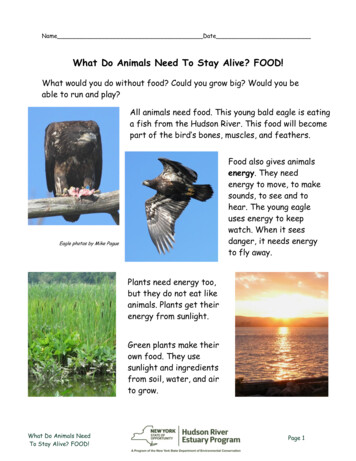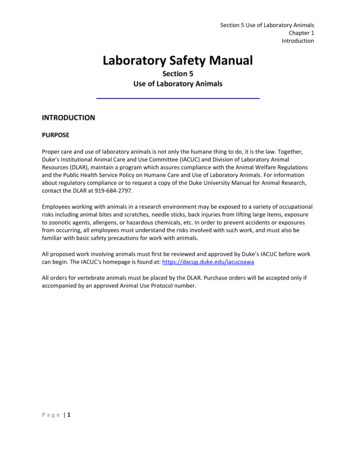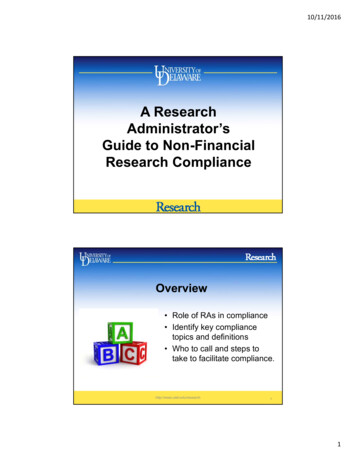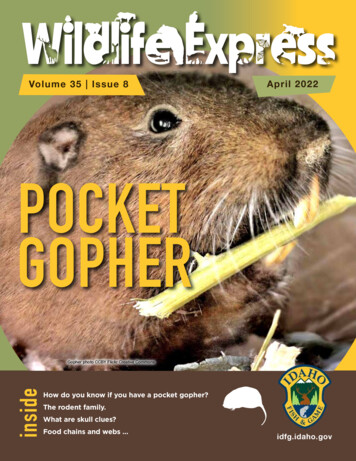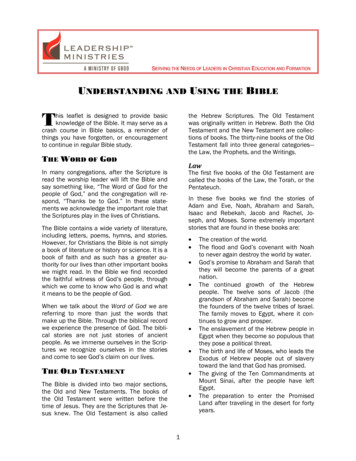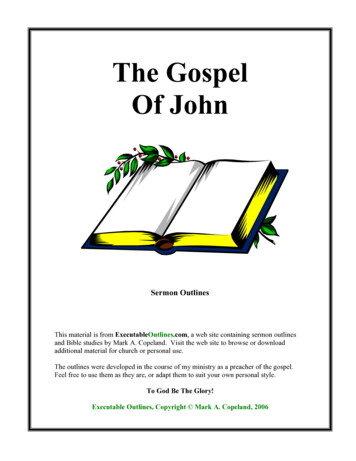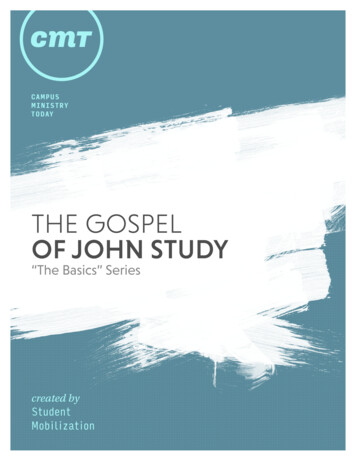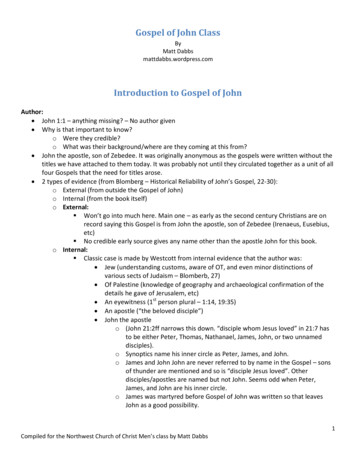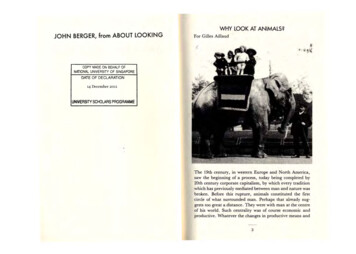
Transcription
WHY LOOK AT ANIMALS?JOHN BERGER, from ABOUT LOOKINGFor Gilles AillaudNov 20111429December2011The 19th century, in western Europe and North America,saw the beginnin g of a process, today being completed by20th century corporate capitalism , by which every traditionwhich has previously mediated between man and nature wasbroken. Before this rupture, animals constituted the firstcircle of what surrounded man . Perhaps (hat already suggests too great a ,distance. They were with man at the centreof his world. Such centrality was of course economic andproductive . Whatever the changes in productive means and3
4WHY LOOK AT ANIMALS?social organisation, men depended upon animals for food,work, transport, clothing.Yet to suppose that animals ftrst entered the humanimagination as meat or leather or horn is to project a 19thcentury attitude backwards across the millenia. Animals firstentered the imagination as messengers and promises. Forexample, the domestication of cattle did not begin as a sim·pie prospect of milk and meat. Cattle had magical functions,sometimes oracular. sometimes sacrificial. And the choice ofa given species as magical, tameable and alimentary wasoriginally determined by the habits, proximity and' 'invitation" of the animal in question.White ox good is my motherAnd we the people of my sister,The people of Nyariau Bul . .Friend, great ox of the spreading horns,which ever bellows amid the herd ,Ox of the son of Bul Maloa .(The Nuer: a description of the modes of livelihood and political institutions of a Nilotic people, by Evans-Pritchard.)Animals are born , are sentient and are mortal . In thesethings they resemble man. In their superficial anatomy less in their deep anatomy - in their habits, in their time, intheir physical capacities, they differ from man . They areboth like and unlike ."We know what animals do and what beaver and bearsand salmon and other creatures need, because once our menwere married to them and they acquired this knowledgefrom their animal wives." (Hawaiian Indians quoted byLevi-Strauss in The Savage Mind.)The eyes of an animal when they consider a man are attentive and wary . The same animal may well look at other5WHY LOOk AT ANIMALS?species in the same way. He does not reserve a special lookfor man. But by no other species except man will theanimal's look be recognised as familiar. Other animals areheld by the look. Man becomes aware of himself returningthe look.The animal scrutinises him across a narrow abyss of noncomprehension. This is why the man can surprise theanimal. Yet the animal - even if domesticated - can alsosurprise the man. The man too is looking across a similar,but not identical, abyss of non-comprehension . And this isso wherever he looks . He is always looking across ignoranceand fear. And so, when he is being seen by the animal. he isbeing seen as his surroundings are seen by him. His recognition of this is what makes the look of the animal familiar.And yet the animal is distinct , and can never be confusedwith man. Thus, a power is ascribed to the animal, comparable with human power but never coinciding with it. Theanimal has secrets which, unlike the secrets of caves, mountains, seas, are specifically addressed to man .The relation may become clearer by comparing the look ofan animal with the look of another man . Between two menthe two abysses are, in principle, bridged by language. Evenif the encounter is hostile and no words are used (even if thetwo speak different languages), the existence of languageallows that at least one of the m, if not both mutually, is confinned by the other. Language allows men to reckon witheach other as with themselves. (In the confirmation madepossible by language, human ignorance and fear may also beconfinued . Whereas in animals fear is a response to signal,in men it is endemic.)No animal confirms man, either positively or negatively.The animal can be killed and eaten so that its energy is added to that which the hunter already possesses . The animal
67WHY LOOK AT ANIMALS?WHY LOOK AT ANIMALS ?can be tamed so that it supplies and works for the peasant .But always its lack of common language , its silence,guarantees its distance, its distinctness, its exclusion, fromand of man .Just because of this distinctness , however , an animal 'slife, never to be confused with a man 's, can be seen to runpa rallel to his . Only in death do the two parallel lines converge and after death, perhaps, cross over to become parallelagain: hence the widespread belief in the transmigration ofsouls.With their parallel lives , anima1s offer man a companionship which is different from any offered by human exchange.Different because il is a companionship offered to theloneliness of man as a species.Such an unspeaking companionship was felt to be so equaltha t often one finds the conviction that it was man who lacked the capacity to speak with animals - hence the storiesand legends of exceptional beings, like Orpheus, who couldtalk with animals in their own la nguage.What were the secrets of the animal's likeness with, andunlikeness from man ? The secrets whose existence man recognised as soon as he intercepted an animal's look.In one sense the whole of anthropology, concerned withthe passage from nature to culture, is an answer to that question. Btl[ there is also a general answer. All the secrets wereabout animals as a n inincession between man and his origin.Darwin's evolutiona ry theory , indelibly stamped as it is withthe marks of the European 19th century nevenhelessbelongs to a tradition, almost as old as man himself.Animals interceded between man and their origin becausethey were both like and unlike man.Animals came from over the horizon . They belonged thertand h.trt. Likew ise they were mortal and immortal. AnIanimal 's blood flowed like human blood, but its species wasundying and each lion was Lion, each ox was Ox. This maybe the first existential dualism - was reflected in thetreatment of animals. They were subjected and worshipped,bred. and sacrificed.Today the vestiges of this dualism remain among thosewho live intimately with, and depend upon , animals, A peasant becomes fond of his pig and is glad to salt away its pork.What is significant, and is so difficult for the urban strangerto understand , is that the two statements in that sentence areconnected by an and and not by a but.The parallelism of their similar/dissimilar lives allowedanimals to provoke some of the first questions and offeranswers . The first subject matter for painting was animal .Probably the first paint was animal blood . Prior to that, it isnot unreasonable to suppose that the first metaphor wasanimal. Rousseau, in his Essay on tM Ongins of Langu.agts,maintained that language itself began with metaphor : "Asemotions were the first motives which induced man to speak,his first utterances were tropes (metaphors). Figurativelanguage was the first to be born, proper meanings were thelast to be found.'If the first metaphor was animal, it was because the essential relation between man and animal was metaphoric.Within that relation what the two terms - man and animal- shared in common revealed what differentiated them.And vice versa.In his book on totemism, Levi-Strauss comments onRousseau 's reasoning: " It is because man originally felthimself identical to all those like him (among which, asRousseau explicitly says, we must include animals) that hecame to acquire the capacity to distinguish h.imst/f as hedistinguishes them - ie, to use the diversity of species forconceptual support for social differentiation ."I
8WHY LOOK AT ANIMALS?To accept Rousseau's explanation of the Orlgms oflanguage is, of course, to beg certain questions (what was theminimal social organisation necessary for the break-throughof language?). Yet no search for origin can ever be fullysatisfied. The intercession of animals in that search was socommon precisely because animals remain ambiguous .All theories of ultimate origin are only ways of betterdefining what followed. Those who disagree with Rousseauare contesting a view of man, not a historical fact. What weafC trYing to define, because the experience is almost lost, isthe universal use of animal-signs for'charting the experienceof the world.Animals were seen in eight out of twelve signs of thezodiac . Among the Greeks, the sign of each of the twelvehours of the day was an animal. (The first a cat, the last acrocodile.) The Hindus envisaged the earth being carried onthe back of an elephant and the dephant on a tortoise. Forthe Nuer of the southern Sudan (see Roy Willis's Man and&asl), "all creatures, including man, originally livedtogether in fellowship in one camp. Dissension began afterFox persuaded Mongoose to throw a club into Elephant'Sface . A quarrel ensued and the animals separated; each wentits own way and began to live as they now are, and to killeach other. Stomach, which at first lived a life of its own inthe bush, entered into man so that now he is always hungry.The sexual organs, which had also been separate, attachedthemselves to men and women, causing them to desire oneanother constantly. Elephant taught man how to poundmillet so that now he satisfies his hunger only by ceaselesslabour. Mouse taught man to beget and women to bear.And Dog brought fire to man."The examples are endless. Everywhere animals offeredexplanations, or more precisely, lent their name or character9WHY LOOK AT ANIMALS?to a quality, which like all qualities, was, in its essence,mysterious.What distinguished man from animals was the humancapacity for symbolic thought, the capacity which was inseparable from the development of language in which wordswere not mere signals, but signifiers of something other thanthemselves. Yet the first symbols were animals. Whatdistinguished men from animals was born of their relationship with them.The Iliad is one of the earliest texts available to us, and init the use of metaphor still reveals the proximity of man andanimal, the proximity from which metaphor itself arose.Homer describes the death of a soldier on the battlefield andthen the death of a horse . Both deaths are equallytransparent to Homer's eyes , there is no more rdraction inone case than the other."Meanwhile, Idomeneus struck Erymas on the mouthwith his relentless bronze . The metal point ofthe spear passed right through the lower pari of his skull, under the brainand smashed the white bones . His teeth were shattered; bothhis eyes were filled with blood; and he spurted blood throughhis nostrils and his gaping mouth. Then the black cloud ofDeath descended on him." That was a man.Three pages further on, it is a horse who falls: "Sarpedon,casting second with his shining spear, missed Patroclus but,struck his horse Pedasus on the right shoulder. The horsewhinnied in the throes of Death, then fell down in the dustand with a great sigh gave up his life." That was animal.Book 17 of the Iliad opens with Menelaus standing overthe corpse of Patroclus to prevent the Trojans stripping it .Here Homer uses animals as metaphoric references, to convey , with irony 0[: admiration, the excessive or superlativequalities of different moments. Without the example of animals,
10WHY LOOK AT ANIMALS?such moments would have remained indescribable ." Menelaus bestrode his body like a fretfu l mothe r cow standing over the first calf she has brought into the world ."A Trojan threatens him, and ironically Menelaus shoutsout to Zeus: " Have you ever seen such arrogance? We knowthe courage of the panther and the lion and the fi erce wildboar, the most high-spirited and self-reliant beast of all, butthat , it seems, is nothing to the prowess of these sons ofPanthous . 1"M enelaus then kills the Trojan who threatened him, andnobody dares approach him. "He was like a mountain lionwho believes in his own strength and pounces on the finestheifer in a grazing herd. He breaks her neck with his powerful jaws, and then he tears her to pieces and devours herblood and entrails, while all around him the herdsmen andtheir dogs create a din but keep their distance - they areheartily scared of him and nothing would induce them toclose in . "Centuries after Homer , Aristotle, in his History oj Animals,the first major scientific work on the subject, systema tisesthe comparative relat ion of man and animal." In the great majority of animals there are traces ofphysical qualities and attitudes , which qualities are moremarkedly differentiated in the case of human beings . Forjust as we pointed out resemblances in the physical organs,so in a number of animals we observe gentleness a ndfi erceness, mildness or cross-temper, courage or timidity ,fear or confidence, high spirits or low cunning, a nd, withregard to intelligence, something akin to sagacity. Some ofthese qual ities in man, as compared with the correspondingqu alities in animals, differ onJy quantitatively: that is to say,man has more or less of this quality, and an animal has moreor less of some other; other qualities in man are represented11W HY LOOK . T . NIM . LS?by analogous and not identical qualities ; for example, just asin man we find knowledge, wisdom a nd sagacity, so in certain animals the re exists some other natural potentiality akinto these . The truth of this statement will be the more clearlyapprehended if we have regard to the phenomena ofchildhood: for in children we observe the traces and seeds ofwhat will one day be settled psychological habits, thoughpsychologically a child ha rdly differs for the time being froman animal ."To most modern "educated" readers, this passage, Ithink, will seem noble but too a nthropomorph ic.Gentleness, cross-temper, sagacity, they would a rgue, arenot moral qualities which can be ascribed to animals. Andthe behaviourists would support this objection.Until the 19th century, however, anthropomorphism wasintegral to the relation between man and animal and was anexpression of their proximity. Anthropomorphism was theresidue of the continuous use of animal metaphor . [n the lasttwo centuries , animals have gradually disappeared. Todaywe live without them. And in this new solitude , anthropomorphism makes us doubly uneasy.T he decisive theore tical break came with Descartes.Descartes internalised , within man, the dualism implicit inthe human relation to animals . In dividing absolutely bodyfrom soul, he bequeathed the body to the laws of physicsand mechanics, and , since animals were soulless , the animalwas reduced to the model of a machine.The consequences of Descartes's break followed onlyslowly . A century later, the great zoologist Buffon, althoughaccepting and us ing the model of the machine in order toclassify animals and their capacities, nevertheless displays atenderness towards animals wh ich temporarily reinstatesthem as companions. This tenderness is half envious.
12WHY LOOK AT ANIMALS?What man has to do in order to transcend the animal totranscend the mechanical within himself, and what his ni que spirituality leads to, is often anguish , And so, by comparison and despite the model of the machine, the animalseems to him to enjoy a kind of innocence . The animal hasbeen emptied of experience and secrets, and Ihis new invented " innocence" begins to provoke in man a kind ofnostalgia. For the first time , animals are placed in a feudingpast . Buffon , writing on the beaver, says this :"To the same degree as man has raised himself above tht:state of natu re, animals have fallen below it: conquered andturned into slaves, or treated as rebels and scattered byforce, their societies have faded away, their industry hasbecome unproductive, their tentative arts have disappeared;each species has lost its general qualities , all of them retaining only their distinct capacit ies, developed in some by example, imitation , education, and in others, by fear andnecessity during the constant watch for survival. What visions and plans can these soulless slaves have, these relics ofthe past without power?"O nly vestiges of their once marvellous indust ry remainin far deserted places, unknown to man for centu ries whereeach species freely used its natural capacities and rfectedthem in peace within a lasting community. The beavers areperhaps the only remaining example, the last monumen t tothat a nimal intelligence . "Although such nostalgia towards animals was a n 18th cen tury invention , countless productive inventions were sti llnecessary - the railway, electricity, the conveyor belt, thecanning industry, the motor car, chemical ferlilisenbefore animals could be marginalised.During the 20th century, the internal combustion enginedisplaced draugh t animals in stree ts a nd factories . C ities,13WHY LOOK AT AN IMALS?growing at an ever increasing rate , transformed the surrou nding countryside into suburbs where field animals, wild ordomesticated, became rare. The commercial exploitation ofcertain species (bison, ligen , reindeer) has rendered themalmost extinct. Such wild life as remains is increasingly confined to national parks and game reserves.Eventually, Descartes's model was surpassed. In the firststages of the industrial revolution, animal s were used asmachines . As also were children . Later, in the so-calledpost-industrial societies, they are treated as raw material.Animals required for food are processed like manufacturedcommodities."Another giant [plant], now under development in NorthCarolina, will cover a total of 150,000 hectares but willemploy only 1,000 people, one for every 15 hectares. Grainswill be sown, nurtured and harvested by machines, including airplanes. They will be fed to the 50,000 cattle andhogs . those animals will never touch the ground. Theywill be bred , suckled and fed to maturity in specially des igned pens." (Susan George's How the Other Half Dies.)This reduction of the anima l, which has a theoretical aswell as economic history, is part of the same process as thatby which men have been reduced to isolated productive andconsuming units . Indeed, during this period an approach toanimals often prefigured an approach to ma n . Themechanical view of the animal's work capacity was laterapplied to that of workers. F. W . Taylor who developed the"Taylorism" of time-motion studies and "scientific"management of industry proposed that work must be "sostupid" and so phlegmatic that he (the worker) " more nearly resembles in his mental make-up the ox than any othertype ." Nearly all modern techniques of social conditioningwere first established with animal experimems. As were also
,.15WHY LOOK AT ANIMALS?WHY LOOK AT ANIMA LS?the methods of so-called intelligence testing. Todaybehaviourisu like Skinner imprison the very concept of manwithin the limits of what they conclude from their artificialtests with animals.Is there not one way in which animals, instead of disappearing, continue to multiply? Never have there been somany household pets as are to be found today in the cities ofthe richest countries. In the United States, it is estimatedthat there are at least forty million dogs, forty million cats,fifteen million cage birds a nd ten million other pets.In the past, families of all classes kept domestic animalsbecause they served a useful purpose - guard dogs, huntingdogs, mice-killing cats , and so on. The practice of keepinganimals regardless of their usefulness , the keeping, exactly,of pets (in the 16th century the word usually referred to alamb raised by hand) is a modern innovation, and . on thesocial scale on which it exists today, is unique. It is part ofthat universal but personal withdrawal into the private smallfamily unit , decorated or furni shed with mementoes fromthe outside world, which is such a distinguishing feature ofconsumer societies .The small family living unit lacks space, earth . otheranimals, seasons , natural temperatures, and so on . The petis either sterilised or sexually isolated, extremely limited inits exercise , deprived of almost all other animal contact, andfed with artificial foods . This is the ma terial process whichlies behind the truism that pets come to resemble theirmasters or mistresses. They are creatures of their owner'sway of life.Equally importa nt is the way the average owner regardshis pet . (C hildren are, briefly , somewhat different .) The petcompletes him , offering responses to aspects of his characterwhich would otherwise remain unconfirmed. He can be tohis pet what he is not to anybody or anything else. Furthermore, the pet can be conditioned to react as though it , too,recognises this. The pet offers its owner a mirror to a partthat is otherwise never reflected. But, since in this relationship the autonomy of both parties has been lost (the ownerhas become the-special-man-he-is-only-to-his-pet, and theanimal has become dependent on its owner for everyphysical need), the parallelism of their separate lives hasbeen destroyed .The cultural marginalisation of animals is, of course, amore complex process than their physical marginalisation .The animals of the mind cannot be so easily dispersed . Sayings, dreams, games, slories, superstitions , the languageitself, recall them. The animals of the mind, instead of beingdispersed , have been co-opted into other categories so thatthe category animtll has lost its central importance. Mostlythey have been co-opted into thefamjry a nd into the spectacle.Those co-opted into the family somewhat resemble pets.But having no physical needs or limitations as pets do , theycan be totally transformed into human puppets . The booksand drawings of Beatrix Potter are an early example; all theanimal productions of the Disney industry are a more recentand extreme one. In such works the pettiness of currentsocial practices is uniutTSalised by being projected on to theanimal kingdom. The following dialogue between DonaldDuck and his nephews is eloquent enough."OONALD: Ma n , what a day! What a perfect day forfishing , boating, dating or picnicking - only I can ' ( do anyof these things!NEPHEW; Why not , Unca Donald? Wha t's holding youback?DONALD: The Bread of Life boys! As usual, I'm broke andits eons till payday.
16WHY LOOK AT ANIMALS?NEPHEW: You could take a walk Unca Donald - go birdwatching.DONALD: (groan!) I may haue to! But ftrst, I'll wait for themailman . He may bring something good newswise!NEPHEW: Like a cheque from an unknown relative inMoneyville?' ,Their physical features apart. these animals have been absorbed into the so-called silent majority.The animals transformed into spectacle have disappearedin another way. In the windows of bookshops at Christmas,a third of the volumes on display are animal picture books.Baby owls or giraffes, the camera fixes them in a domainwhich, although entirely visible to the camera, will never beentered by the spectator. All animals appear like fish seenthrough the plate glass of an aquarium. The reasons for thisace both technical and ideological: Technically the devicesused to obtain ever more arresting images - hiddencameras, telescopic lenses, flashlights, remote controls andso on - combine to produce pictures which carry with themnumerous indications of their normal invisibility. The imagesexist thanks only to the existence of a technical clairvoyance.A rece nt, very well-produced book of animal photographs(La File &uvage by Frederic R ossi ) announces in its preface: Each of these pictures lasted in real time less than threehundredths of a second, they are far beyond the capacity ofthe human eye. What we see here is something never beforeseen, because it is totally invisible."[n the accompanying ideology, animals are always theobserved. The fact that they can observe us has lost allsignificance. They are the objects of our ever-extendingknowledge . What we know about them is an index of ourpower, and thus an index of what separates us from them.The more we know, the further away they are .17WHY LOOK AT ANIMALS?Yet in the same ideology, as Lukacs points out in HistorymuJ Class Consciousness, nature is also a value concept. Avalue opposed to the social institutions which strip man ofhis natural essence and imprison him. "Nature thereby acquires the meaning of what has grown organically, what wasnot created by man, in contrast to the artificial structures ofhuman civilisation. At the same time, it can be understoodas that aspect of human inwardness which has remainednatural, or at least tends or longs to become natural oncemore." According to this view of nature, the life of a wildanimal becomes an ideal, an ideal internalised as a feelingsurrounding a repressed desire . The image of a wild animalbecomes the starting-point of a daydream: a point fromwhich the day-dreamer departs with his back turned.The degree of confusion involved is illustrated by thefollowing news story: "London housewife Barbara Carterwon a 'grant a wish' charity contest, and said she wanted tokiss and cuddle a lion. Wednesday night she was in ahospital in shock and with throat wounds. Mrs Carter, 46,was taken to the lions' compound of the safari park atBewdley , W ednesday. As she bent forward to stroke thelioness, Suki, it pounced and dragged her to the ground.Wardens later said. ' We seem to have made a bad error ofjudgment. We have always regarded the lioness as perfectlysafe'. "The treatment of animals in 19th century romantic painting was already an acknowledgement of the ir impendingdisappearance. The images are of animals receding into aWildness that existed only in the imagination. There was,however, one 19th century anist, who was obsessed by thetransformation about to take place, and whose work was anuncanny illustration of it. Grandville published his Public andPri/Jt1.te Life rJj Animtlu in instalments between 1840 and 1842 .
,.WHY LOOK AT ANIMALS ?At first sight, Grandville's animals, dressed up and performing as men and women, appear to belong to the oldtradition, whereby a person is portrayed as an animal so asto reveal more clearly an aspect of his or her character. Thedevice was like putting on a mask, but its function was to unmask. The animal represents the apogee of the charactertrait in question: the lion , absolute courage: the hare,lechery . The animal once lived near the origin of the quality.It was through the animal that the quality first becamerecognisable . And so the animal lends it his name.Jr' '"' .--:! 19WHY LOOK AT A N IMALS?But as one goes on looking at Grandville 's engravings,one becomes aware that the shock which they conveyderives, in fact, from the opposite movement to that whichone first assumed. These animals are not being "borrowed"to explain people , nothing is being unmasked ; on the contrary. These animals have become prisoners of ahuman/social situation into which they have been pressganged. The vulture as landlord is more dreadfullyrapacious than he is as a bird. The crocodiles at dinner aregreedier at the table than they are in the river.Here animals are not being used as reminders of origin, oras moral metaphors, they are being used m masse to"people" situations. The movement that ends with thebanality of Disney , began as a disturbing, prophetic dreamin the work of Grandville.The dogs in Gra ndville 's engraving of the dog-pound arein no way canine; they have dogs faces, but what they aresuffering is imprisonment like men.The bear is a good lathtr shows a bear dejectedly pulling apram like any other human bread-winner. Grandville's firstvolume ends with the words "Goodnight then, dear reader.Go home, lock your cage well, sleep tight and have pleasantdreams. Until tomorrow." Animals and populace arebecoming synonymous , which is to say the animals arefading away.A later Grandville drawing, entided The animo.ls entering theSWam ark, is explicit. In the Judaeo-Christian tradition ,Noah's Ark was the first ordered assembly of animals andman. The assembly is now over. Grandville shows us thegreat departure . On a quayside a long queue of differentspecies is filing slowly away, their backs towards us. Theirpostures suggest all the last minute doubts of emigrants. Inthe distance is a ramp by which the first have already
20WHY LOOK AT ANIMALS?entered the 19th century ark, which is like an Americansteamboat. The bear. The lion . The donkey . The cameLThe cock. The fox. Exeunt. 'About 1867, " according to the London Zoo Guifk, "amusic hall anist called the Great Vance sang a song calledWalking in the zoo is the OK thing to do, and the word 'zoo'came into everyday use . London Zoo also brought the word'Jumbo' into the English language. Jumbo was an Africanelephant of mammoth size, who lived at the zoo between1865 and 1882. Queen Victoria took an interest in him andeventually he ended his days as the star of the famous Bar-21WHY LOOK AT ANIMALS?nurn circus which travelled through America - his nameliving on to describe things of giant proportions. "Public zoos came into existence at the beginning of theperiod which was to see the disappearance of animals fromdaily life. The zoo to which people go to meet animals, toobserve them, to see them, is , in fact, a monument to the impossibility of such encounters. Modern zoos are an epitaphto a relationship which was as old as man. They are not seenas such because the wrong questions have been addressed tozoos .When they were founded - the London Zoo in 1828, theJardin des Plantes in 1793, the Berlin Zoo in 1844, theybrought considerable prestige to the national capitals. Theprestige was not so different from that which had accrued tothe private royal menageries . These menageries, along withgold plate , architecture, orchestras , players, furnishings,dwarfs , acrobats, uniforms, horses, art and food , had beendemonstrations of an emperor's or king's power and wealth.Likewise in the 19th century , public zoos were an endorsement of modern colonial power. The capturing of theanimals was a symbolic representation of the conquest of alldistant and ex
The eyes of an animal when they consider a man are at tentive and wary. The same animal may well look at other . 5 . WHY LOOk AT ANIMALS? species in the same way. He does not reserve a special look for man. But by no other species except man will the animal's look . be . recognised as familiar. Other animals are held by the look.

